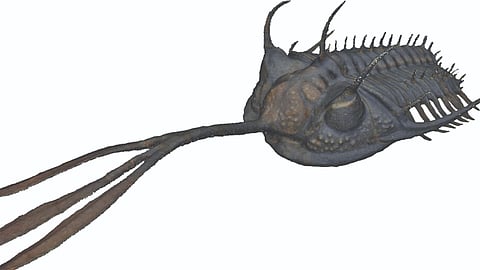

Walliserops trifurcatus wasn’t like the other trilobites. Sure, it had a body like a cross between a pillbug and a horseshoe crab. But it also wielded an immense, flat-bladed trident, projecting from its front like an oversize hood ornament and conjuring the three-tipped tool of the Greek god Poseidon (known to the Romans as Neptune).
In research published Monday in the Proceedings of the National Academy of Science, two scientists argue that the three-inch-long creature’s trident served as a weapon for jousting with rival males some 400 million years ago, in perhaps the earliest known example of specialized sexual combat.
“When we see something like the fork on Walliserops, it suggests sexual selection because it’s really extreme,” said Alan Gishlick, a paleontologist at Bloomsburg University of Pennsylvania and an author on the study. “It’s just a question of how you test it.”
Sexual selection — anatomical traits that emerge through millenniums of accumulation of a species’ romantic whims — produces some of the strangest features in animals today, Dr. Gishlick said. Sometimes, they’re decorations to attract a female’s eye, like a peacock’s tail feathers or the vibrant colors on a lizard’s belly. Occasionally they’re for dueling, as males battle one another for access to females, as in deer antlers.
“Methods of sexual combat probably go back as long as there are complex organisms having sex,” Dr. Gishlick said. But identifying sexually selected traits in extinct animals is trickier, in part because it’s impossible to observe their social behavior. That’s led some researchers to err on the side of caution, and search for alternate practical explanations for crests, spines — or tridents.
Since its description in 2001 after discovery in Morocco, some trilobite researchers have suggested that Walliserops’ three-bladed fork was a defensive weapon. Others have guessed it might serve as a feeding tool. But Dr. Gishlick and his colleague Richard Fortey, a paleontologist at the Natural History Museum in London, dismissed both possibilities: The long, stiff trident isn’t mobile enough for effective defense, and it is too long and oddly angled for foraging. The team brought in another line of evidence: a Walliserops specimen on display at the Houston Museum of Natural Science, which grew to maturity with a deformed trident. Wild animals with serious deformities in their feeding or defensive mechanisms generally don’t survive to adulthood, Dr. Gishlick said.
But malformed sexual selection structures are different. “They don’t actually hinder survival,” he said. “A peacock with a bunch of dull, short feathers might even live longer. They just don’t help you mate.”
The scientists measured various Walliserops specimens’ tridents and compared them with those of living rhinoceros beetles, which have elaborate headgear that males use to battle one another. Some, like the caliper rhinoceros beetle, fence with long, straight points. Others attempt to wrestle and pry.
Visit news.dtnext.in to explore our interactive epaper!
Download the DT Next app for more exciting features!
Click here for iOS
Click here for Android